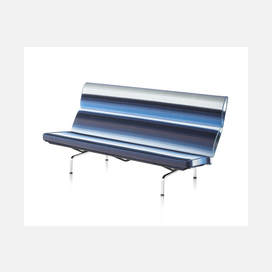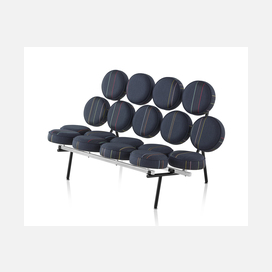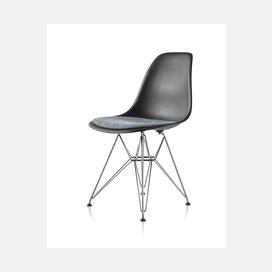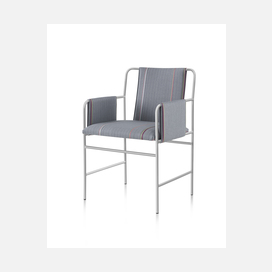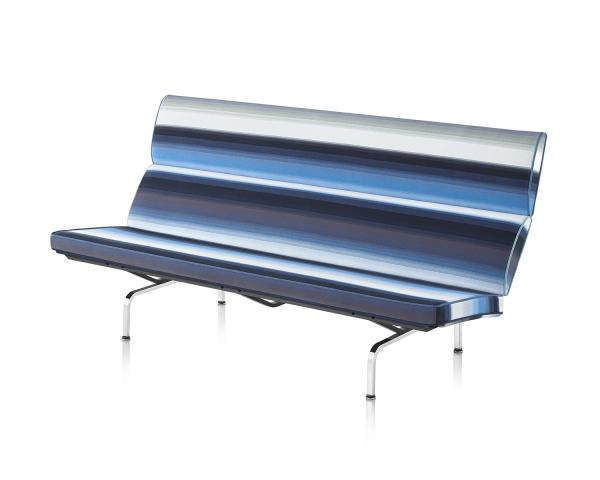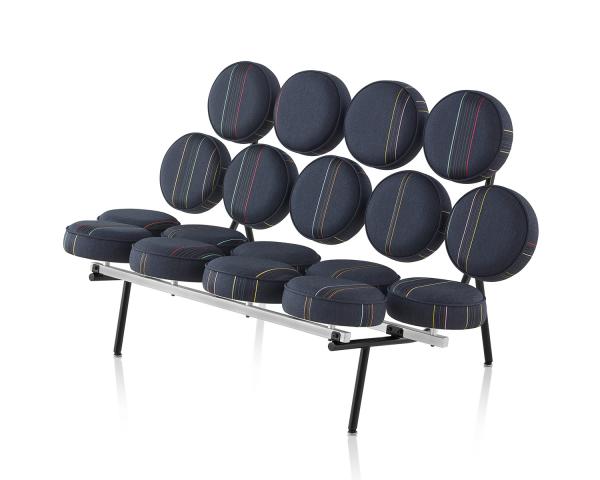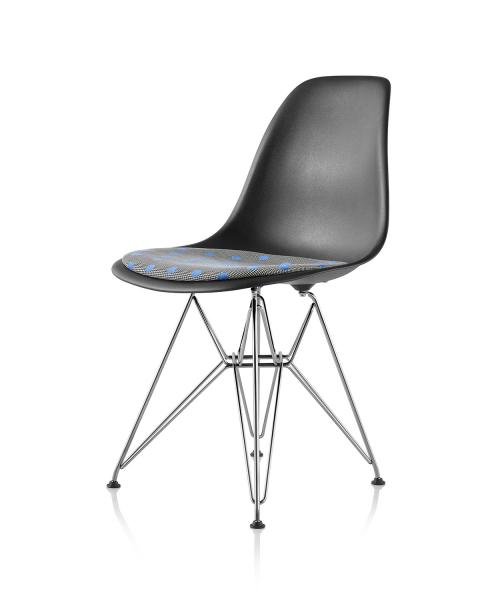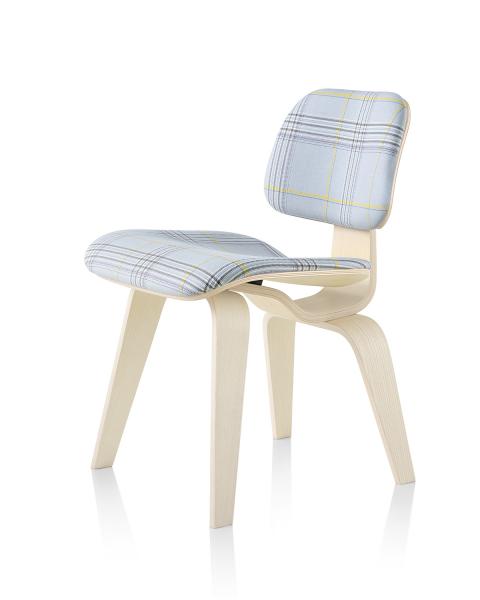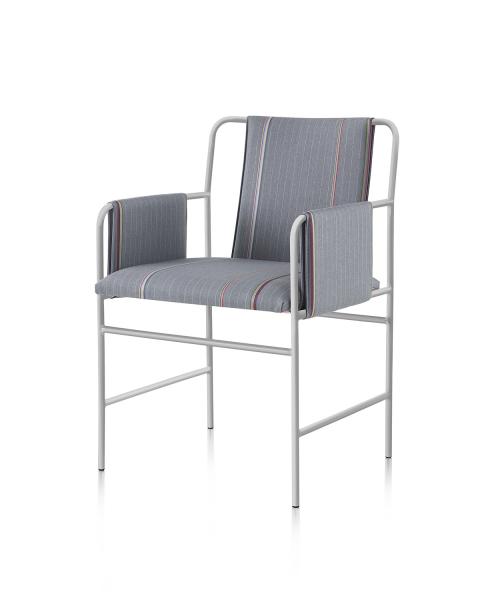In collaboration since 2002, Paul Smith and Maharam have generated a vibrant range of textiles that translate traditional suiting concepts to interiors: reinterpreting quintessential apparel motifs like houndstooth, plaid, polka dots, and stripes through idiosyncratic combinations of color. Now the two entities are partnering on an exclusive assortment of iconic pieces from the Herman Miller Collection that give new meaning to Smith’s “classics with a twist” approach. Launching at Herman Miller’s Tokyo flagship store on October 1, an exhibit will showcase this concise selection of midcentury designs reimagined by Smith in alternately tailored, whimsical, and artful textiles.
Among the five pieces are three instantly recognizable styles by Charles and Ray Eames, including the Eames Sofa Compact, which originated in the 1940s as a built-in design for the Eameses’ own Pacific Palisades home. The current freestanding version, which is perfectly scaled for small spaces but still comfortably seats three, has been in continuous production since 1954. Its sleek, rectilinear frame now provides an ideal canvas for Smith’s latest textile, Blended Stripe, an uninterrupted ombre that pairs light neutrals with cool shades of turquoise, cobalt and navy blue. A fusion of pattern and texture, Blended Stripe is woven in a dense cotton epinglé construction that’s notable for its fine loops, low pile, matte finish, and cool hand.
The Eames Molded Plywood Chair is well known for using the same innovative technology pioneered by the Eameses during World War II. (Commissioned by the US Navy, they developed lightweight plywood splints, stretchers and glider shells formed by heat and pressure.) After the war, this same technology was applied to making high-quality chairs that could be affordably mass-produced. Sculpted to support the human body, the Eames Molded Plywood Chair is suitable for homes and businesses alike. Here its slim profile is enhanced by an application of Mingled Plaid by Paul Smith. A spacious windowpane plaid woven of worsted wool, Mingled Plaid’s dove gray ground lifts the chair’s white ash frame while injections of citron and magenta introduce a modern, fashion-forward take on Scottish heritage.
Similarly, the Eames Molded Plastic Chair with a chrome Eiffel Tower base gets a graphic revamp courtesy of Dots by Paul Smith. Based on a woven silk necktie featured in his Spring/Summer 2017 menswear collection, Dots juxtaposes a miniature houndstooth with a bold polka dot rendered in lustrous mercerized cotton, yielding material contrast and a deep sense of overlaid space. This distinctly playful yet understated design underscores Smith’s and the Eameses’ shared penchant for practical, adaptable designs infused with an undeniable sense of curiosity and fun. The Molded Plastic Chair’s single-shell form, (originally manufactured in fiberglass in 1950), epitomizes the Eames tenet, “the best for the most for the least.”
Conversely, the Envelope Chair, designed by Ward Bennett in 1966 and now manufactured by Geiger, is all business in Bespoke Stripe by Paul Smith. The Envelope’s minimal, welded tubular steel frame is tautly wrapped by Smith’s first joint effort with Maharam. Designed in 2003, Bespoke Stripe embeds ribbons of color within a classic menswear pinstripe. Featuring a smooth worsted wool construction that’s just heavier than suiting weight, Bespoke Stripe is woven in the United Kingdom. The sporadic placement of stripes across the textile’s full width allows for, in the bespoke tradition, the opportunity to customize how fabric meets furniture.
The concept of enabling uniqueness—often seen in unexpected or hidden details throughout the clothing he designs—is captured in the application of Smith’s Herringbone Stripe to George Nelson’s whimsical Marshmallow Sofa (1956). Composed of eighteen separate cushions that appear to float on a steel frame, the Marshmallow makes a statement in any setting. Herringbone Stripe continues the theme of men’s haberdashery with a toothy wool herringbone providing a textural foil for colorful bands of lustrous sateen. Vivid continuous and intermittent stripes are positioned at random intervals, creating a formal yet spirited effect.
The collaboration between Paul Smith and Maharam began in 2002 after Smith discovered I Morosi alla Finestra (The Lovers at the Window) at a Gio Ponti retrospective at the Design Museum in London. (Designed in 1930, this finely woven, figurative silk window covering was reissued by Maharam in 2002 as part of its ongoing Textiles of the 20th Century™ collection.) Smith’s request to repurpose I Morosi alla Finestra as a jacket lining was met with a reciprocal invitation to design a textile of his own. Since then, Paul Smith and the Maharam Design Studio have produced more than twenty-five imaginative textiles for seating and wallcovering alike—from a plethora of inimitable signature stripes to a series of photorealistic game-themed prints. When asked the secret behind their enduring creative exchange, Mary Murphy, Maharam’s senior vice president of design, explains “He’s just so exuberant, and he’s always got all these ideas going on constantly.” She continues, “I think he represents design being who you are; it’s not a career for him, it’s his life.”
According to Paul Smith: “I’ve been designing furniture fabric with Maharam for many years and I’m delighted that it’s been so well-received. It’s used in theatres, in cinemas and by a lot of famous design companies all over the world. I’m delighted to be able to choose furniture to apply the fabric onto. To see the Paul Smith and Maharam designs on some of Herman Miller’s most iconic pieces like the Eames Chairs and the Nelson Marshmallow Sofa is an absolute honor.”
Says Ben Matsuzaki, managing director of Herman Miller Japan: “I am very excited to launch the new Maharam upholstered furniture pieces today in our Herman Miller Store Tokyo. These beautiful and original textiles have been brought to life by Maharam in collaboration with Paul Smith. Touching the fabric and sitting on the chairs, you will find exceptional craftmanship and quality. I hope these special collection pieces will be able to enrich the lives of our customers.”
A storewide installation celebrating Paul Smith and Maharam for Herman Miller Collection will be on
view at Herman Miller’s Tokyo flagship until October 21.
About Herman Miller
Herman Miller is a globally recognized provider of furnishings and related technologies and services. Headquartered in West Michigan, the 113-year-old company has relied on innovative design to solve problems wherever people work, live, learn, and heal. With recognizable designs as part of museum collections worldwide, Herman Miller is a past recipient of the Smithsonian Institution’s Cooper Hewitt National Design Award and has been ranked number one on Contract magazine’s list of “Brands that Inspire” for four straight years. Known and respected for its leadership in corporate social responsibility, Herman Miller has earned numerous global sustainability and inclusivity awards including the Human Rights Foundation’s top rating in its Corporate Equality Index for 11 years in a row.
About Paul Smith
Sir Paul Smith is one of Britain’s foremost designers. He is renowned for his creative spirit, which combines tradition and modernity. Famous for its clothing and accessories collections, Paul Smith specializes in an inventive use of traditional craftsmanship and cutting-edge design to create beautifully made, desirable, modern pieces. Paul Smith is loved across the world. From its origins in one small shop in Nottingham, England, in 1970, Paul Smith has grown into a global business, selling in over seventy countries. Starting with one men’s collection, the business now comprises collections for men, women and children, including, shoes, accessories, fragrance and home furnishings. Throughout its development Paul Smith’s values of curiosity, quality and authenticity have remained constant.
